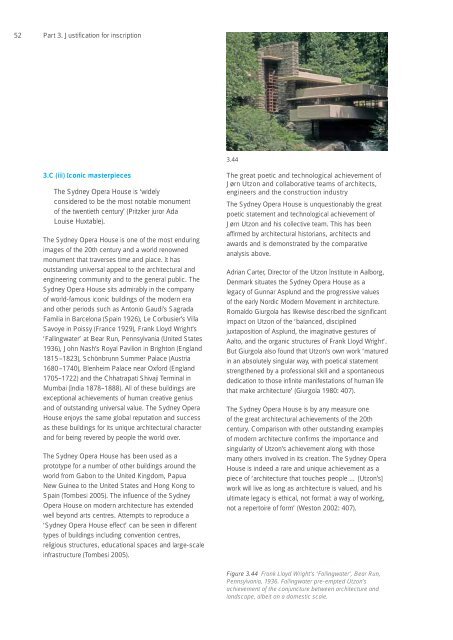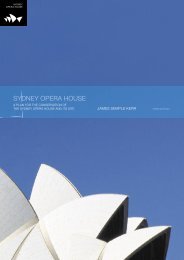nomination by the Government of Australia - Sydney Opera House
nomination by the Government of Australia - Sydney Opera House
nomination by the Government of Australia - Sydney Opera House
Create successful ePaper yourself
Turn your PDF publications into a flip-book with our unique Google optimized e-Paper software.
52<br />
Part 3. Justifi cation for inscription<br />
3.C (iii) Iconic masterpieces<br />
The <strong>Sydney</strong> <strong>Opera</strong> <strong>House</strong> is ‘widely<br />
considered to be <strong>the</strong> most notable monument<br />
<strong>of</strong> <strong>the</strong> twentieth century’ (Pritzker juror Ada<br />
Louise Huxtable).<br />
The <strong>Sydney</strong> <strong>Opera</strong> <strong>House</strong> is one <strong>of</strong> <strong>the</strong> most enduring<br />
images <strong>of</strong> <strong>the</strong> 20th century and a world renowned<br />
monument that traverses time and place. It has<br />
outstanding universal appeal to <strong>the</strong> architectural and<br />
engineering community and to <strong>the</strong> general public. The<br />
<strong>Sydney</strong> <strong>Opera</strong> <strong>House</strong> sits admirably in <strong>the</strong> company<br />
<strong>of</strong> world-famous iconic buildings <strong>of</strong> <strong>the</strong> modern era<br />
and o<strong>the</strong>r periods such as Antonio Gaudi’s Sagrada<br />
Familia in Barcelona (Spain 1926), Le Corbusier’s Villa<br />
Savoye in Poissy (France 1929), Frank Lloyd Wright’s<br />
‘Fallingwater’ at Bear Run, Pennsylvania (United States<br />
1936), John Nash’s Royal Pavilion in Brighton (England<br />
1815 –1823), Schönbrunn Summer Palace (Austria<br />
1680 –1740), Blenheim Palace near Oxford (England<br />
1705–1722) and <strong>the</strong> Chhatrapati Shivaji Terminal in<br />
Mumbai (India 1878–1888). All <strong>of</strong> <strong>the</strong>se buildings are<br />
exceptional achievements <strong>of</strong> human creative genius<br />
and <strong>of</strong> outstanding universal value. The <strong>Sydney</strong> <strong>Opera</strong><br />
<strong>House</strong> enjoys <strong>the</strong> same global reputation and success<br />
as <strong>the</strong>se buildings for its unique architectural character<br />
and for being revered <strong>by</strong> people <strong>the</strong> world over.<br />
The <strong>Sydney</strong> <strong>Opera</strong> <strong>House</strong> has been used as a<br />
prototype for a number <strong>of</strong> o<strong>the</strong>r buildings around <strong>the</strong><br />
world from Gabon to <strong>the</strong> United Kingdom, Papua<br />
New Guinea to <strong>the</strong> United States and Hong Kong to<br />
Spain (Tombesi 2005). The infl uence <strong>of</strong> <strong>the</strong> <strong>Sydney</strong><br />
<strong>Opera</strong> <strong>House</strong> on modern architecture has extended<br />
well beyond arts centres. Attempts to reproduce a<br />
‘<strong>Sydney</strong> <strong>Opera</strong> <strong>House</strong> effect’ can be seen in different<br />
types <strong>of</strong> buildings including convention centres,<br />
religious structures, educational spaces and large-scale<br />
infrastructure (Tombesi 2005).<br />
3.44<br />
The great poetic and technological achievement <strong>of</strong><br />
Jørn Utzon and collaborative teams <strong>of</strong> architects,<br />
engineers and <strong>the</strong> construction industry<br />
The <strong>Sydney</strong> <strong>Opera</strong> <strong>House</strong> is unquestionably <strong>the</strong> great<br />
poetic statement and technological achievement <strong>of</strong><br />
Jørn Utzon and his collective team. This has been<br />
affi rmed <strong>by</strong> architectural historians, architects and<br />
awards and is demonstrated <strong>by</strong> <strong>the</strong> comparative<br />
analysis above.<br />
Adrian Carter, Director <strong>of</strong> <strong>the</strong> Utzon Institute in Aalborg,<br />
Denmark situates <strong>the</strong> <strong>Sydney</strong> <strong>Opera</strong> <strong>House</strong> as a<br />
legacy <strong>of</strong> Gunnar Asplund and <strong>the</strong> progressive values<br />
<strong>of</strong> <strong>the</strong> early Nordic Modern Movement in architecture.<br />
Romaldo Giurgola has likewise described <strong>the</strong> signifi cant<br />
impact on Utzon <strong>of</strong> <strong>the</strong> ‘balanced, disciplined<br />
juxtaposition <strong>of</strong> Asplund, <strong>the</strong> imaginative gestures <strong>of</strong><br />
Aalto, and <strong>the</strong> organic structures <strong>of</strong> Frank Lloyd Wright’.<br />
But Giurgola also found that Utzon’s own work ‘matured<br />
in an absolutely singular way, with poetical statement<br />
streng<strong>the</strong>ned <strong>by</strong> a pr<strong>of</strong>essional skill and a spontaneous<br />
dedication to those infi nite manifestations <strong>of</strong> human life<br />
that make architecture’ (Giurgola 1980: 407).<br />
The <strong>Sydney</strong> <strong>Opera</strong> <strong>House</strong> is <strong>by</strong> any measure one<br />
<strong>of</strong> <strong>the</strong> great architectural achievements <strong>of</strong> <strong>the</strong> 20th<br />
century. Comparison with o<strong>the</strong>r outstanding examples<br />
<strong>of</strong> modern architecture confi rms <strong>the</strong> importance and<br />
singularity <strong>of</strong> Utzon’s achievement along with those<br />
many o<strong>the</strong>rs involved in its creation. The <strong>Sydney</strong> <strong>Opera</strong><br />
<strong>House</strong> is indeed a rare and unique achievement as a<br />
piece <strong>of</strong> ‘architecture that touches people … [Utzon’s]<br />
work will live as long as architecture is valued, and his<br />
ultimate legacy is ethical, not formal: a way <strong>of</strong> working,<br />
not a repertoire <strong>of</strong> form’ (Weston 2002: 407).<br />
Figure 3.44 Frank Lloyd Wright’s ‘Fallingwater’, Bear Run,<br />
Pennsylvania, 1936. Fallingwater pre-empted Utzon’s<br />
achievement <strong>of</strong> <strong>the</strong> conjuncture between architecture and<br />
landscape, albeit on a domestic scale.

















